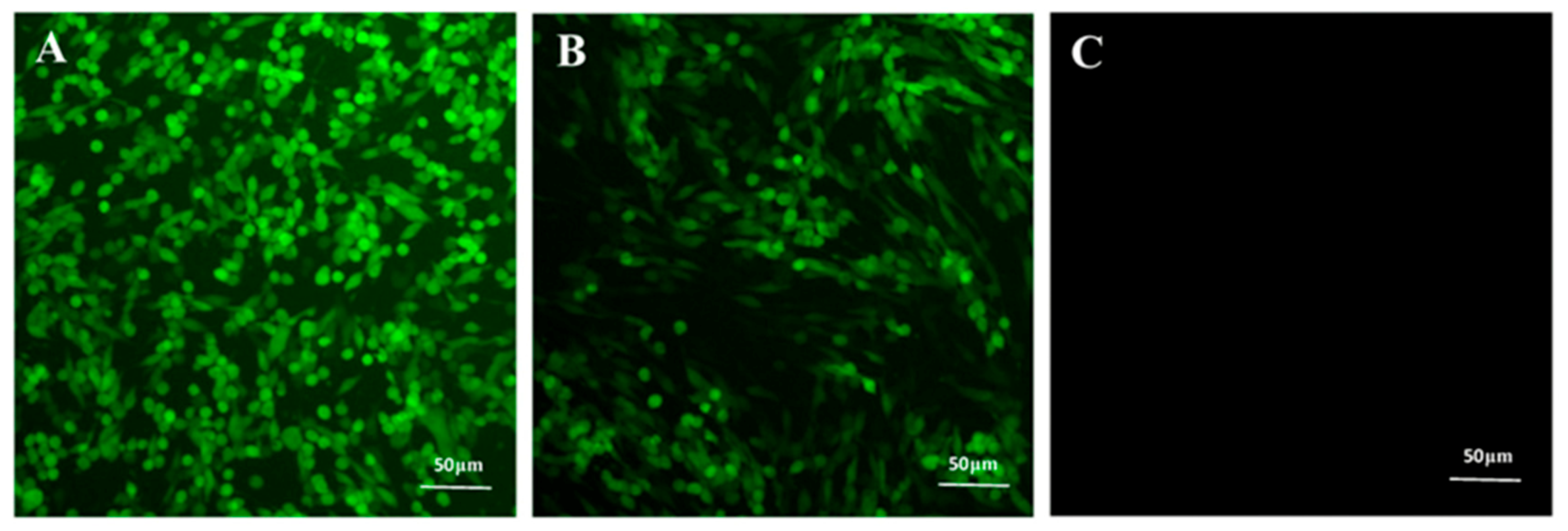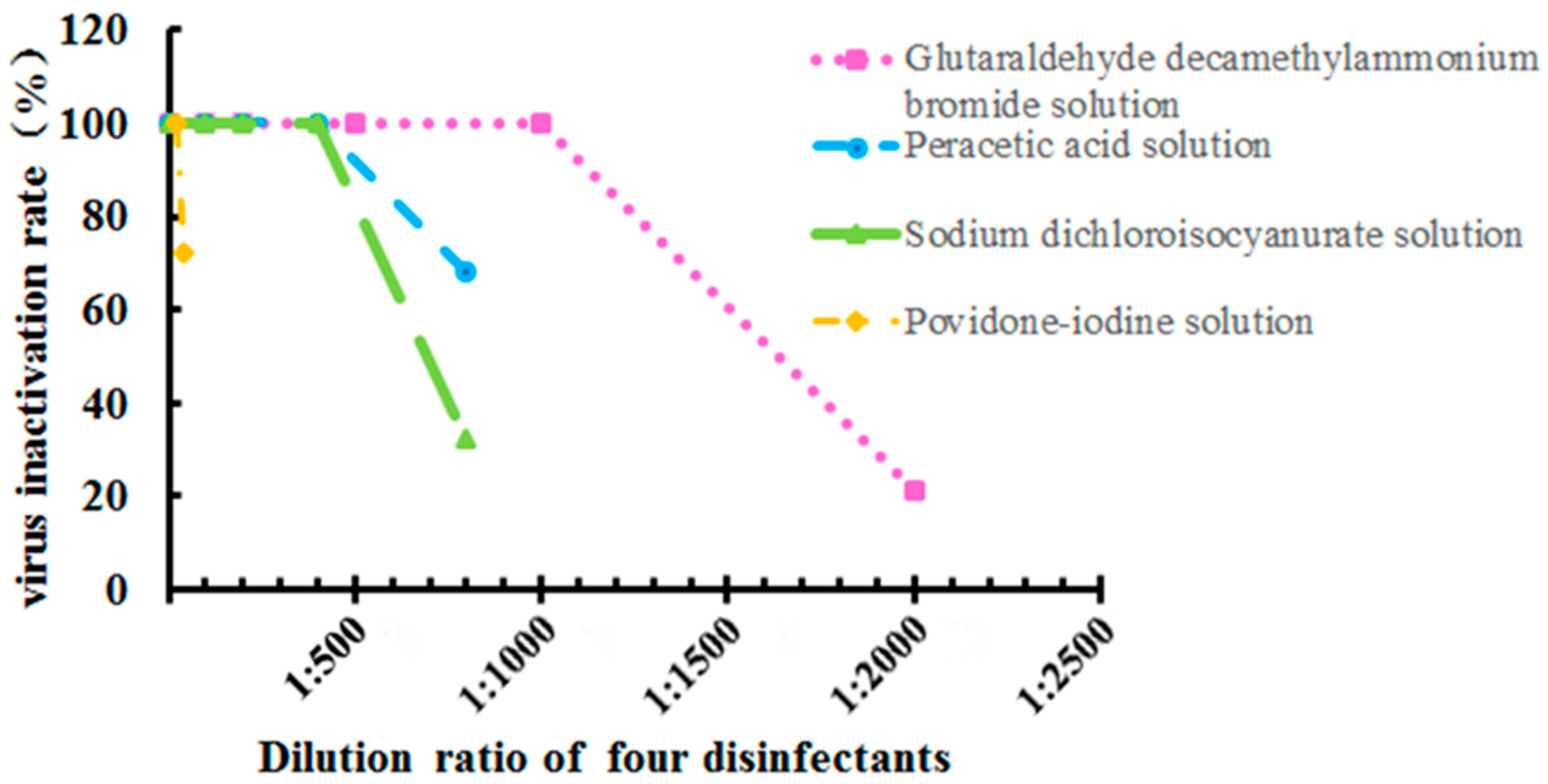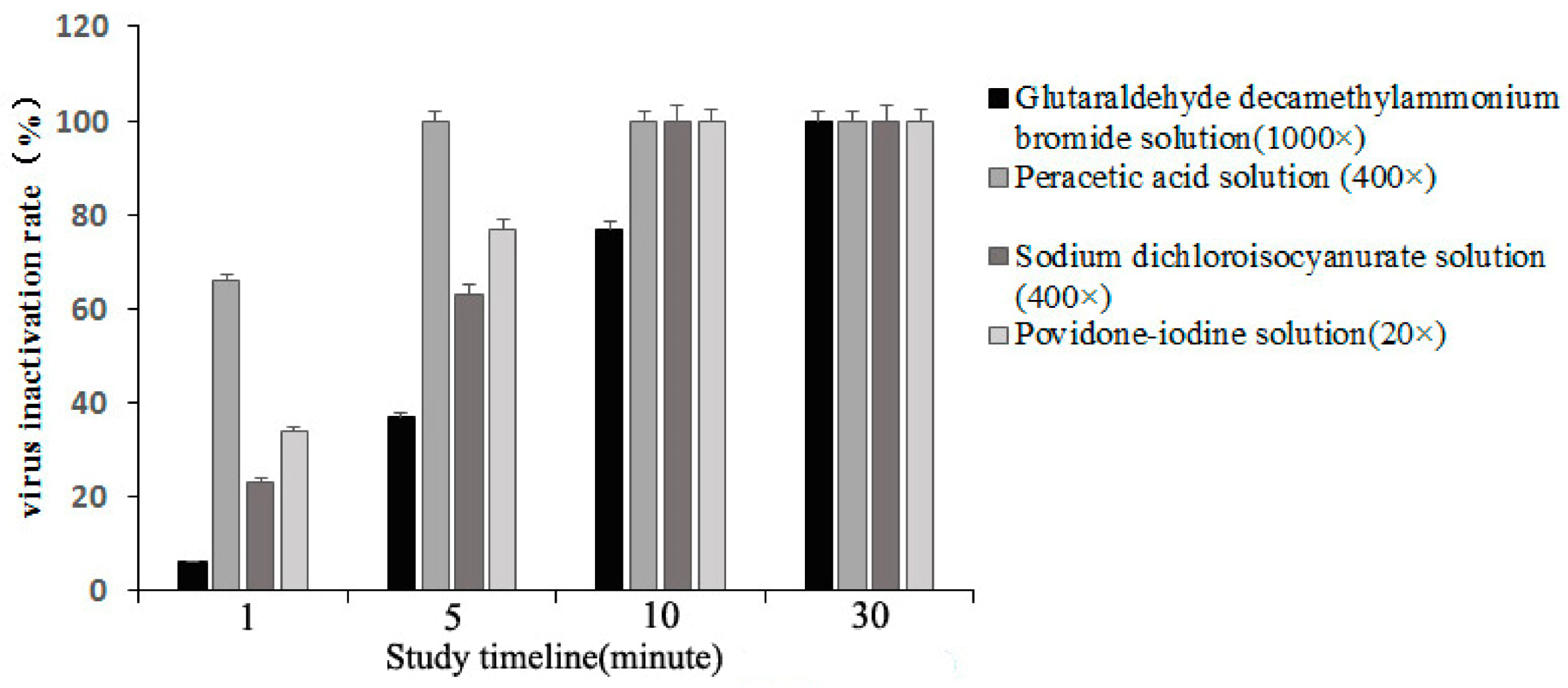Inactivation Performance of Pseudorabies Virus as African Swine Fever Virus Surrogate by Four Commercialized Disinfectants
Abstract
1. Introduction
2. Materials and Methods
2.1. Cells and Viruses
2.2. Reagents
2.2.1. Selection of Disinfectants
2.2.2. Neutralizers Corresponding to Different Disinfectants
2.2.3. Preparation of Standard Hard Water
2.3. Proliferation and Measurement Titer of rPRV-ZJ on BHK-21 Cells
2.4. Effects of Neutralizer, Disinfectant, and Neutralized Products on the Growth of BHK-21 Cells
2.5. Establishment of Evaluation Model for Cell Disinfection
2.5.1. Virus Disinfection
2.5.2. Measurements of Minimum Effective Content of Disinfectant
2.5.3. Disinfection Performances Based on Onset and Action Time
2.5.4. Effects of Temperature on Disinfection Performances
3. Results
3.1. Proliferation of rPRV-ZJ in BHK-21 Cells and Measurement of TCID50
3.2. Effects of Neutralizers, Disinfectants, and Neutralized Products on the Growth of BHK-21 Cells
3.3. Effects of Disinfectant on Virus Proliferation
3.4. Minimum Effective Content of Four Disinfectants
3.5. Disinfection Performances Based on Onset and Action Time
3.6. Effects of Temperature on Disinfection Performances of Disinfectants
4. Discussion
5. Conclusions
Author Contributions
Funding
Institutional Review Board Statement
Informed Consent Statement
Data Availability Statement
Acknowledgments
Conflicts of Interest
References
- Costard, S.; Mur, L.; Lubroth, J.; Sanchez-Vizcaino, J.M.; Pfeiffer, D.U. Epidemiology of African Swine Fever Virus. Virus Res. 2013, 173, 191–197. [Google Scholar] [CrossRef] [PubMed]
- Sánchez-Cordón, P.J.; Montoya, M.; Reis, A.L.; Dixon, L.K. African Swine Fever: A Re-Emerging Viral Disease Threatening the Global Pig Industry. Vet. J. 2018, 233, 41–48. [Google Scholar] [CrossRef] [PubMed]
- Mazur-Panasiuk, N.; Żmudzki, J.; Woźniakowski, G. African Swine Fever Virus—Persistence in Different Environmental Conditions and the Possibility of Its Indirect Transmission. J. Vet. Res. 2019, 63, 303–310. [Google Scholar] [CrossRef] [PubMed]
- Cwynar, P.; Stojkov, J.; Wlazlak, K. African Swine Fever Status in Europe. Viruses 2019, 63, 310. [Google Scholar] [CrossRef]
- Zhou, X.; Li, N.; Luo, Y.; Liu, Y.; Miao, F.; Chen, T.; Zhang, S.; Cao, P.; Li, X.; Tian, K.; et al. Emergence of African Swine Fever in China, 2018. Transbound. Emerg. Dis. 2018, 65, 1482–1484. [Google Scholar] [CrossRef]
- Zhao, D.; Liu, R.; Zhang, X.; Li, F.; Wang, J.; Zhang, J.; Liu, X.; Wang, L.; Zhang, J.; Wu, X.; et al. Replication and Virulence in Pigs of the First African Swine Fever Virus Isolated in China. Emerg. Microbes Infect. 2019, 8, 438–447. [Google Scholar] [CrossRef]
- Ge, S.; Li, J.; Fan, X.; Liu, F.; Li, L.; Wang, Q.; Ren, W.; Bao, J.; Liu, C.; Wang, H.; et al. Molecular Characterization of African Swine Fever Virus, China, 2018. Emerg. Infect. Dis. 2018, 24, 2131–2133. [Google Scholar] [CrossRef]
- Eblé, P.L.; Hagenaars, T.J.; Weesendorp, E.; Quak, S.; Moonen-Leusen, H.W.; Loeffen, W.L.A. Transmission of African Swine Fever Virus via Carrier (Survivor) Pigs Does Occur. Vet. Microbiol. 2019, 237, 108345. [Google Scholar] [CrossRef]
- Gallardo, C.; Sánchez, E.G.; Pérez-Núñez, D.; Nogal, M.; de León, P.; Carrascosa, Á.L.; Nieto, R.; Soler, A.; Arias, M.L.; Revilla, Y. African Swine Fever Virus (ASFV) Protection Mediated by NH/P68 and NH/P68 Recombinant Live-Attenuated Viruses. Vaccine 2018, 36, 2694–2704. [Google Scholar] [CrossRef]
- Dixon, L.K.; Stahl, K.; Jori, F.; Vial, L.; Pfeiffer, D.U. African Swine Fever Epidemiology and Control. Annu. Rev. Anim. Biosci. 2020, 8, 221–246. [Google Scholar] [CrossRef]
- Kalenic, S.; Horvatic, J.; Lynch, P. Networking Hospital Infection Control in 10 Countries in Southeast Europe. Am. J. Infect. Control 2005, 33, e77–e78. [Google Scholar] [CrossRef]
- Arias, M.; de la Torre, A.; Dixon, L.; Gallardo, C.; Jori, F.; Laddomada, A.; Martins, C.; Parkhouse, R.M.; Revilla, Y.; Rodriguez, F.; et al. Approaches and Perspectives for Development of African Swine Fever Virus Vaccines. Vaccines 2017, 5, 35. [Google Scholar] [CrossRef] [PubMed]
- Fiori, M.S.; Sanna, D.; Scarpa, F.; Floris, M.; Di Nardo, A.; Ferretti, L.; Loi, F.; Cappai, S.; Sechi, A.M.; Angioi, P.P.; et al. A Deeper Insight into Evolutionary Patterns and Phylogenetic History of Asfv Epidemics in Sardinia (Italy) through Extensive Genomic Sequencing. Viruses 2021, 13, 1994. [Google Scholar] [CrossRef] [PubMed]
- Schulz, K.; Schulz, J.; Staubach, C.; Blome, S.; Nurmoja, I.; Conraths, F.J.; Sauter-Louis, C.; Viltrop, A. African Swine Fever Re-Emerging in Estonia: The Role of Seropositive Wild Boar from an Epidemiological Perspective. Viruses 2021, 13, 2121. [Google Scholar] [CrossRef]
- Shirai, J.; Kanno, T.; Tsuchiya, Y.; Mitsubayashi, S.; Seki, R. Effects of Chlorine, Iodine, and Quaternary Ammonium Compound Disinfectants on Several Exotic Disease Viruses. J. Vet. Med. Sci. 2000, 62, 85–92. [Google Scholar] [CrossRef]
- Gallina, L.; Scagliarini, A. Virucidal Efficacy of Common Disinfectants against Orf Virus. Vet. Rec. 2010, 166, 724–725. [Google Scholar] [CrossRef]
- Jeffrey, D.J. Chemicals Used as Disinfectants: Active Ingredients and Enhancing Additives. Rev. Sci. Tech. 1995, 14, 57–74. [Google Scholar] [CrossRef]
- Dellanno, C.; Vega, Q.; Boesenberg, D. The Antiviral Action of Common Household Disinfectants and Antiseptics against Murine Hepatitis Virus, a Potential Surrogate for SARS Coronavirus. Am. J. Infect. Control 2009, 37, 649–652. [Google Scholar] [CrossRef]
- Hulkower, R.L.; Casanova, L.M.; Rutala, W.A.; Weber, D.J.; Sobsey, M.D. Inactivation of Surrogate Coronaviruses on Hard Surfaces by Health Care Germicides. Am. J. Infect. Control 2011, 39, 401–407. [Google Scholar] [CrossRef]
- Juszkiewicz, M.; Walczak, M.; Wozniakowski, G. Characteristics of Selected Active Substances Used in Disinfectants and Their Virucidal Activity against ASFV. J. Vet. Res. 2019, 63, 17–25. [Google Scholar] [CrossRef]
- Jiang, C.; Gang, S.U.N.; Zhang, F.; Ai, X.; Feng, X.-N.; Hu, W.; Zhang, X.-F.; Zhao, D.-M.; Bu, Z.-G.; He, X.-J. Viricidal Activity of Several Disinfectants against African Swine Fever Virus. J. Integr. Agric. 2021, 20, 3084–3088. [Google Scholar] [CrossRef]
- Bicknell, D.L.; Jain, R.K. Ozone Disinfection of Drinking Water—Technology Transfer and Policy Issues. Environ. Eng. Policy 2001, 3, 55. [Google Scholar] [CrossRef]
- Wales, A.D.; Gosling, R.J.; Bare, H.L.; Davies, R.H. Disinfectant Testing for Veterinary and Agricultural Applications: A Review. Zoonoses Public Health 2021, 68, 361–375. [Google Scholar] [CrossRef] [PubMed]
- Böttcher, B.; Sarg, B.; Lindner, H.H.; Nagl, M. Inactivation of Microbicidal Active Halogen Compounds by Sodium Thiosulphate and Histidine/Methionine for Time-Kill Assays. J. Microbiol. Methods 2017, 141, 42–47. [Google Scholar] [CrossRef]
- Martel, J.A.; Chatterjee, P.; Coppin, J.D.; Williams, M.; Choi, H.; Stibich, M.; Simmons, S.; Passey, D.; Jinadatha, C. Capturing Portable Medical Equipment Disinfection Data via an Automated Novel Disinfection Tracking System. Am. J. Infect. Control 2021, 49, 1287–1291. [Google Scholar] [CrossRef]
- Reed, L.J.; Muench, H. A Simple Method of Estimating Fifty per Cent Endpoints. Am. J. Epidemiol. 1938, 27, 493–497. [Google Scholar] [CrossRef]
- Bellini, S.; Rutili, D.; Guberti, V. Preventive Measures Aimed at Minimizing the Risk of African Swine Fever Virus Spread in Pig Farming Systems. Acta Vet. Scand. 2016, 58, 82. [Google Scholar] [CrossRef]
- Juszkiewicz, M.; Walczak, M.; Mazur-Panasiuk, N.; Woźniakowski, G. Effectiveness of Chemical Compounds Used against African Swine Fever Virus in Commercial Available Disinfectants. Pathogens 2020, 9, 878. [Google Scholar] [CrossRef]
- De Lorenzi, G.; Borella, L.; Alborali, G.L.; Prodanov-Radulović, J.; Štukelj, M.; Bellini, S. African Swine Fever: A Review of Cleaning and Disinfection Procedures in Commercial Pig Holdings. Res. Vet. Sci. 2020, 132, 262–267. [Google Scholar] [CrossRef]
- Karger, A.; Pérez-Núñez, D.; Urquiza, J.; Hinojar, P.; Alonso, C.; Freitas, F.B.; Revilla, Y.; Le Potier, M.F.; Montoya, M. An Update on African Swine Fever Virology. Viruses 2019, 11, 864. [Google Scholar] [CrossRef]
- Sánchez-Vizcaíno, J.M.; Mur, L.; Gomez-Villamandos, J.C.; Carrasco, L. An Update on the Epidemiology and Pathology of African Swine Fever. J. Comp. Pathol. 2015, 152, 9–21. [Google Scholar] [CrossRef] [PubMed]
- Black, D.N.; Brown, F. Purification and Physicochemical Characteristics of African Swine Fever Virus. J. Gen. Virol. 1976, 32, 509–518. [Google Scholar] [CrossRef] [PubMed]
- Durani, P.; Leaper, D. Povidone-Iodine: Use in Hand Disinfection, Skin Preparation and Antiseptic Irrigation. Int. Wound J. 2008, 5, 376–387. [Google Scholar] [CrossRef] [PubMed]
- Flynn, J. Povidone-Iodine as a Topical Antiseptic for Treating and Preventing Wound Infection: A Literature Review. Br. J. Community Nurs. 2003, 8, S36–S42. [Google Scholar] [CrossRef] [PubMed]
- Lin, S.; Li, G.; Huang, H. Comparative Study of the Disinfection Effects of Three Types of Conjunctiva Sac Irrigations. Eye Sci. 2013, 28, 20–23. [Google Scholar]
- Zhou, P.; Li, L.-F.; Zhang, K.; Wang, B.; Tang, L.; Li, M.; Wang, T.; Sun, Y.; Li, S.; Qiu, H.-J. Deletion of the H240R Gene of African Swine Fever Virus Decreases Infectious Progeny Virus Production Due to Aberrant Virion Morphogenesis and Enhances Inflammatory Cytokine Expression in Porcine Macrophages. J. Virol. 2022, 96, e0166721. [Google Scholar] [CrossRef]
- Salas, M.L.; Andrés, G. African Swine Fever Virus Morphogenesis. Virus Res. 2013, 173, 29–41. [Google Scholar] [CrossRef]
- Harvey, E.; Holmes, E.C. Diversity and Evolution of the Animal Virome. Nat. Rev. Microbiol. 2022, 20, 321–334. [Google Scholar] [CrossRef]
- Rossmann, M.G. Structure of Viruses: A Short History. Q. Rev. Biophys. 2013, 46, 133–180. [Google Scholar] [CrossRef]
- FAO. Manual on the Preparation of African Swine Fever Contingency Plans; FAO: Rome, Italy, 2001. [Google Scholar]




| Disinfectant Category | Effective Content (g/mL) | Virus Inactivation Rate (%) | |||
|---|---|---|---|---|---|
| Action Temperature | Action Time | ||||
| 30 min | 60 min | 180 min | |||
| Glutaraldehyde decamethylammonium bromide solution | 1 × 10−4 | 4 °C | 27 | 27 | 70 |
| 37 °C | 100 | 100 | 100 | ||
| Peracetic acid solution | 5 × 10−4 | 4 °C | 100 | 100 | 100 |
| 37 °C | 100 | 100 | 100 | ||
| Sodium dichloroisocyanurate solution | 5 × 10−4 | 4 °C | 100 | 100 | 100 |
| 37 °C | 100 | 100 | 100 | ||
| Povidone-iodine solution | 2.5 × 10−3 | 4 °C | 100 | 100 | 100 |
| 37 °C | 100 | 100 | 100 | ||
Disclaimer/Publisher’s Note: The statements, opinions and data contained in all publications are solely those of the individual author(s) and contributor(s) and not of MDPI and/or the editor(s). MDPI and/or the editor(s) disclaim responsibility for any injury to people or property resulting from any ideas, methods, instructions or products referred to in the content. |
© 2023 by the authors. Licensee MDPI, Basel, Switzerland. This article is an open access article distributed under the terms and conditions of the Creative Commons Attribution (CC BY) license (https://creativecommons.org/licenses/by/4.0/).
Share and Cite
Ni, Z.; Chen, L.; Yun, T.; Xie, R.; Ye, W.; Hua, J.; Zhu, Y.; Zhang, C. Inactivation Performance of Pseudorabies Virus as African Swine Fever Virus Surrogate by Four Commercialized Disinfectants. Vaccines 2023, 11, 579. https://doi.org/10.3390/vaccines11030579
Ni Z, Chen L, Yun T, Xie R, Ye W, Hua J, Zhu Y, Zhang C. Inactivation Performance of Pseudorabies Virus as African Swine Fever Virus Surrogate by Four Commercialized Disinfectants. Vaccines. 2023; 11(3):579. https://doi.org/10.3390/vaccines11030579
Chicago/Turabian StyleNi, Zheng, Liu Chen, Tao Yun, Ronghui Xie, Weicheng Ye, Jionggang Hua, Yinchu Zhu, and Cun Zhang. 2023. "Inactivation Performance of Pseudorabies Virus as African Swine Fever Virus Surrogate by Four Commercialized Disinfectants" Vaccines 11, no. 3: 579. https://doi.org/10.3390/vaccines11030579
APA StyleNi, Z., Chen, L., Yun, T., Xie, R., Ye, W., Hua, J., Zhu, Y., & Zhang, C. (2023). Inactivation Performance of Pseudorabies Virus as African Swine Fever Virus Surrogate by Four Commercialized Disinfectants. Vaccines, 11(3), 579. https://doi.org/10.3390/vaccines11030579






